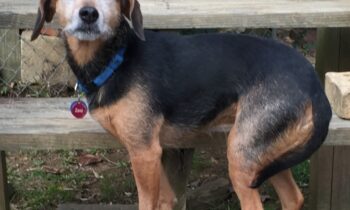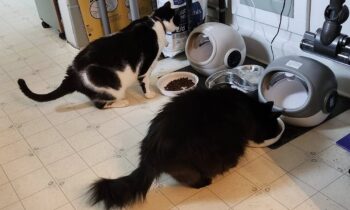
Last week, I wrote about why doggy nail trimming is needed to protect your dog’s health, longevity, and comfort. This week, I’ve got a few tips for those of you who are novices at dog nail trimming.
First, set the dog up for success.
Puppies may have had their first nail trims from their breeders. If that trimming was done properly, the puppies have experienced no pain, discomfort, or stress during the process. They have also been rewarded, so their first impression of nail trimming is that it’s closely allied with getting treats and other good stuff, like attention and praise, from their humans.
Your puppy has had a great head-start if her breeder properly trimmed her nails and made it a pleasant experience for her. Ask the breeder to show you what to do and how to do it—maybe on an older dog, possibly the puppies’ mother. Breeders wanting the best for their puppies will gladly help you learn how to do it correctly. Your job will be to continue nail trimming on a regular basis when you get the puppy home, always making it pleasant and rewarding—never scary and painful.
If you’ve adopted a puppy from a shelter or rescue, or possibly from an unknowledgeable or “backyard” breeder, from a puppy mill, or even from a “reputable” pet store, the chances are that your puppy has never had her nails trimmed. That’s not the worst thing that could happen. Once the puppy comes home with you, you will get the chance to introduce her gently and kindly to a procedure she will learn to accept—and possibly even enjoy—for the rest of her life. But remember, the entire situation will be foreign to her and the unfamiliar may be frightening.
Paw-handling first, long before trimming!
Your puppy should learn to accept and enjoy being held and being handled. Most puppies with uneventful backgrounds are eager to get into your arms and happy to be petted—even hugged. Your puppy should not be fearful of getting near humans or of having humans handle her body. Should your puppy show fear of human handling, consider why. Has she had some scary experiences that you don’t know about? Has she ever been handled before, or was she stuck in a cage with no contact? Is the puppy really “all there” physically and mentally?
Any doubts on your part about the temperament of a puppy that is new to your family—especially if you see what you think is fear or aggression—should indicate your immediate need for professional help. The first step would be a visit to your veterinarian for what’s often called a “well puppy visit”—a chance for you and the pup to have a pleasant experience at the clinic while your veterinarian and vet techs check out her basic vitals, physical condition, and general deportment. If the veterinarian feels that your puppy might have “issues” with fear or aggression, ask for a referral to a veterinary behaviorist or well-qualified dog behavior counselor in your area so that you can have a professional consultation.
Sometimes, a new puppy has so many “issues” that it may become clear to you that this particular puppy is simply a very poor fit for your family, if you have neither the time nor the financial means to work through those “issues” with her so she can become a more well-balanced and happy dog.
Don’t feel you’ve failed. You picked the wrong match, that’s all.
You should be able to return the puppy to wherever you got her and get your money back. If that’s not possible—and it won’t be if you haven’t chosen well—consider looking for a specialized rescue group that might put the puppy in a foster home where she can get the help she needs, along with a chance at a good life after her bad beginning. It is not your responsibility to keep her if you know you cannot handle her. It is your responsibility to get her to a safe place where experienced people can help her. Those places do exist!

Paw-handling is where good nail-trimming practices begin.
Frequently—every day, as often as possible—sit down on the floor (or outside on the ground) so that your puppy will have easy access to you. If the puppy seems uninterested in coming close to you, start there: make coming close to you rewarding! Don’t reach out or grab at the pup—instead, entice her with treats, toys, a gentle voice, lots of encouragement. Once the puppy is close to you, offer your hands for her to smell and explore. When you’re sure that your hands aren’t scary to the pup, start stroking her gently. I’d try a little under-chin scratching, which puppies often enjoy.
Finally, when you are very sure your puppy is enjoying the experience, run your hands down her legs and gently touch her paws. If she pulls away, try to figure out why. What could you do better? If at any time she leaves, figure out why. Did you go on too long? Was there a distraction nearby? Don’t forget that almost all puppies have very short attention spans. Don’t expect your handling sessions to last longer than a few minutes each, at most. Stop while your puppy still wants more!
When you can touch the paws without the puppy noticing—no flinching or pulling away—it’s time to move on to holding the paw. Very, very gently! If you pull on the paw, the puppy will pull back. It’s called the opposition reflex. She really can’t help it, because that’s what she’s hardwired to do. Instead, think of “holding hands” instead of restraint. Again, this must be a pleasant experience for the puppy. Don’t forget the quiet, gentle praise and, for most puppies, food treats.
For adult dogs, the procedure is much the same. However, it’s likely to take much longer to acclimate a grown dog whose body has not been handled and whose paws have not been touched. Worse yet, an adult dog who has had bad experiences with handling and nail trimming is very likely to be extremely difficult to persuade that you intend him no hurt or harm. If the adult dog has, for some reason, been handled roughly—even just in play—and hurt, your job will be to change his mind so that, eventually, with much patience and work on your part, he will come to see handling and grooming not only as a regular part of his life, but also as a pleasant experience he can enjoy.
Again, if you have a “new to you” adult dog who resists handling, is frightened of humans, or is aggressive (biting, not just mouthing), please consult a veterinarian, who can check to see if there is a physical cause for the dog’s behavior—illness, injury, extreme sensitivity—and who will be able to recommend appropriate help if the “issues” should be discussed with a qualified behavior specialist. Should these “issues” turn out to be more than you can handle or afford, it would be wise to consider that this dog is not a good fit for your situation. If the dog has come from a good shelter or rescue, they will take him back. If you found the dog free online, take him to a good shelter or rescue rather than return him to an uncertain future with someone who didn’t want him in the first place!
Paw-handling as pre-training for nail trimming is mandatory.
How long it takes to accustom your puppy or dog to paw handling depends very much on her past experiences. If she’s had no bad experiences (from her point of view), you’re starting with a clean slate. That is a great situation. Keep in mind, though, that she’s also had no good experiences yet, either. Don’t expect her to “get with the program” simply because you know it’s best for her. It’s your job to convince the pup or dog that paw-handling is always rewarding—you must “make it so.”
Remember that wild animals in zoos and wildlife parks are now regularly accustomed to health care and husbandry procedures that allow their veterinarians and caregivers to administer meds, give shots, and handle their body parts without restraint or force—which is pretty amazing, when you think about it. Leo the Lion at the zoo can learn it, and so can your Fido or Fifi!
Next week, I’ll explain what comes after paw handling!



